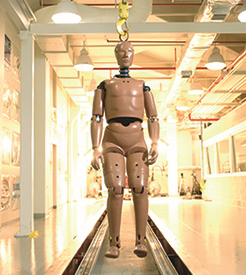Title
Insult to the human cadaver patellofemoral joint: effects of age on fracture tolerance and occult injury
Document Type
Article
Publication Date
11-1-1995
Publication Title
SAE International
Abstract
Lower extremity (knee) trauma is currently based on a bone fracture criterion derived from impacts of aged specimens. Recent clinical studies, however, indicate that a chronic disease (post-traumatic osteoarthritis), may be precipitated after mechanical insult without obvious bone fracture(1). It is hypothesized this is due to microcracking of subchondral bone under cartilage. This hard tissue layer is known to change with age and pathology. Ten ‘aged’ (71 years) and ten ‘young’ (47 years) cadaver knee joints were impacted to study the influence of age and pathology on the fracture load, and incidents of occult injury. Our results indicate that fracture load, per se, was independent of specimen age. On the other hand, severely pathological specimens required significantly higher loads to fracture bone. Occult microcraking was also observed in subfracture experiments, however, fewer incidents were recorded for the ‘aged’ specimens. This type of injury has been associated with knee pain and the development of disease in the chronic setting. These data suggest that a bone fracture criterion based largely on pathological specimens would not provide a conservative measure of tolerance for the normal driving population.
DOI
10.4271/952729
ISSN
0148-7191
Rights
©1995 SAE International. All Rights Reserved.
Recommended Citation
Haut, Roger C. and Atkinson, Patrick J., "Insult to the human cadaver patellofemoral joint: effects of age on fracture tolerance and occult injury" (1995). Crash Safety Center Publications. 39.
https://digitalcommons.kettering.edu/crash_pubs/39



Comments
39th Stapp Car Crash Conference (1995) SAE Technical Paper 952729